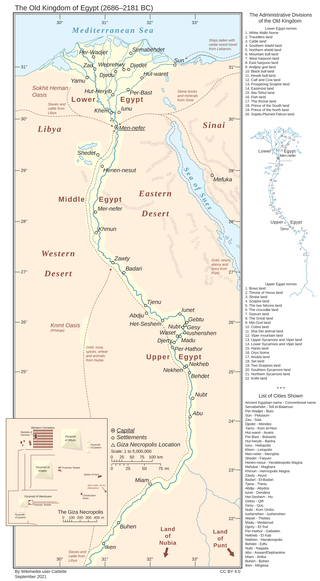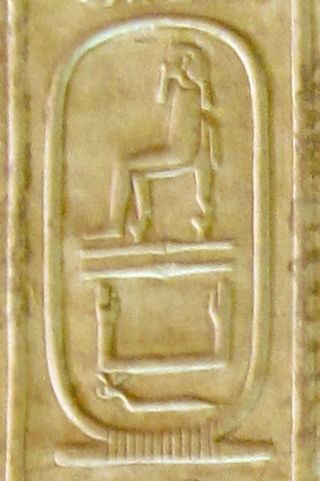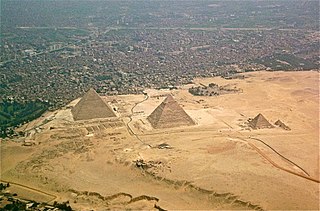Khuenre | |
|---|---|
 | |
| Burial place | Tomb MQ 1 at Giza |
| Title | Prince of Egypt |
| Parent(s) | King Menkaure Queen Khamerernebty II |
Khuenre (Khuenra) was a Prince of ancient Egypt of the 4th Dynasty, named after the Sun god Ra.
Khuenre | |
|---|---|
 | |
| Burial place | Tomb MQ 1 at Giza |
| Title | Prince of Egypt |
| Parent(s) | King Menkaure Queen Khamerernebty II |
Khuenre (Khuenra) was a Prince of ancient Egypt of the 4th Dynasty, named after the Sun god Ra.
He was a son of Pharaoh Menkaure and his sister, Queen Khamerernebty II. [2] He was a grandson of Khafre and Khamerernebty I and great-grandson of Khufu, the king who built the Great Pyramid of Giza. [3] [4]
He was a secretary and "sole companion of his father". [5]
He was the eldest son of his parents, but he was not Menkaure’s successor. [6] This was Shepseskaf. [7]
Khuenre is buried in Menkaure’s cemetery (MQ 1). He is depicted as a young boy standing in front of his seated mother on the south wall. [5]

In ancient Egyptian history, the Old Kingdom is the period spanning c. 2700–2200 BC. It is also known as the "Age of the Pyramids" or the "Age of the Pyramid Builders", as it encompasses the reigns of the great pyramid-builders of the Fourth Dynasty, such as King Sneferu, who perfected the art of pyramid-building, and the kings Khufu, Khafre and Menkaure, who constructed the pyramids at Giza. Egypt attained its first sustained peak of civilization during the Old Kingdom, the first of three so-called "Kingdom" periods, which mark the high points of civilization in the lower Nile Valley.

Menkaure, was a pharaoh of the Fourth Dynasty of Egypt during the Old Kingdom, who is well known under his Hellenized names Mykerinos and Menkheres. According to Manetho, he was the throne successor of king Bikheris, but according to archaeological evidence, he was almost certainly the successor of Khafre. Africanus reports as rulers of the fourth dynasty Sôris, Suphis I, Suphis II, Mencherês (=Menkaure), Ratoisês, Bicheris, Sebercherês, and Thamphthis in this order. Menkaure became famous for his tomb, the Pyramid of Menkaure, at Giza and his statue triads, showing the king together with his wives Rekhetre and Khamerernebty and with various deities.

Khafre was an ancient Egyptian pharaoh of the Fourth Dynasty during the Old Kingdom. He was the son of Khufu and the successor of Djedefre.

The Fourth Dynasty of ancient Egypt is characterized as a "golden age" of the Old Kingdom of Egypt. Dynasty IV lasted from c. 2613 to 2494 BC. It was a time of peace and prosperity as well as one during which trade with other countries is documented.

Shepseskaf was a pharaoh of ancient Egypt, the sixth and probably last ruler of the fourth dynasty during the Old Kingdom period. He reigned most probably for four but possibly up to seven years in the late 26th to mid-25th century BC.

The pyramid of Menkaure is the smallest of the three main pyramids of the Giza pyramid complex, located on the Giza Plateau in the southwestern outskirts of Cairo, Egypt. It is thought to have been built to serve as the tomb of the Fourth Dynasty Egyptian Pharaoh Menkaure.

The Giza pyramid complex in Egypt is home to the Great Pyramid, the Pyramid of Khafre, and the Pyramid of Menkaure, along with their associated pyramid complexes and the Great Sphinx. All were built during the Fourth Dynasty of the Old Kingdom of ancient Egypt, between 2600 and 2500 BC. The site also includes several temples and cemeteries and the remains of a workers' village.

Mark Lehner is an American archaeologist with more than 30 years of experience excavating in Egypt. He was born in North Dakota in 1950. His approach, as director of Ancient Egypt Research Associates (AERA), is to conduct interdisciplinary archaeological investigation. Every excavated object is examined by specialists to create an overall picture of an archaeological site—from the buildings down to the pollen spores. His international team currently runs the Giza Plateau Mapping Project, excavating and mapping the ancient city of the builders of the Giza pyramid complex, which dates to the fourth dynasty of Egypt. He discovered that Pyramid G1-a, one of the subsidiary pyramids of the Great Pyramid, belonged to Hetepheres I; it was originally thought to belong to Queen Meritites I.

The Giza Plateau is a limestone plateau in Giza, Egypt, the site of the Fourth Dynasty Giza pyramid complex, which includes the pyramids of Khufu, Khafre and Menkaure, the Great Sphinx, several cemeteries, a workers' village and an industrial complex. It forms the northernmost part of the 16,000 ha Pyramid Fields in the Western Desert edge of the Nile Valley that are part of the UNESCO World Heritage Site, Memphis and its Necropolis.

Queen Meresankh III was the daughter of Hetepheres II and Prince Kawab and a granddaughter of the Egyptian pharaoh Khufu. She was the wife of King Khafre.
Djedefhor or Hordjedef was a noble Egyptian of the 4th Dynasty. He was the son of Pharaoh Khufu and his name means "Enduring Like Horus".
Khamerernebty I was an ancient Egyptian queen of the 4th dynasty. She was probably a wife of King Khafre and the mother of King Menkaure and Queen Khamerernebty II. It is possible that she was a daughter of Khufu, based on the fact that inscriptions identify her as a King's daughter.
Khamerernebty II was an ancient Egyptian queen of the 4th Dynasty. She was a daughter of Pharaoh Khafre and Queen Khamerernebty I. She married her brother Menkaure and she was the mother of Prince Khuenre.

Mindjedef was a Prince of ancient Egypt, who lived during the 4th Dynasty. His name means "Enduring Like Min". Min is an Egyptian fertility god.

Khentkaus I, also referred to as Khentkawes, was a royal woman who lived in ancient Egypt during both the Fourth Dynasty and the Fifth Dynasty. She may have been a daughter of king Menkaure, the wife of both king Shepseskaf and king Userkaf, the mother of king Sahure. Some suggest that she was the regent for one of her sons. Perhaps, in her own right, she may have been the king of Upper and Lower Egypt, which aspects of her burial suggest. Her mastaba at Giza – tomb LG100 – is located very close to Menkaure's pyramid complex. This close connection may point to a family relationship. Although the relationship is not clear, the proximity of the pyramid complex of Khentkaus to that of king Menkaure has led to the conjecture that she may have been his daughter.
Duaenre was a vizier under Menkaure during the Fourth Dynasty of Egypt. His titles include those of king's son of his body, hereditary prince, count, vizier (tAjtj), scribe of the divine book, mouth of Nekhen, and mouth of every Butite.
Sekhemkare was a vizier from the Fifth Dynasty of Egypt. He was a son of king Khafre and queen Hekenuhedjet. He served as vizier during the beginning of the next dynasty, during the reigns of Userkaf and Sahure. Sekhemkare is the only son of Khafre whose death can be fairly securely dated to a precise reign, here that of Sahure.

Bikheris is the Hellenized name of an ancient Egyptian pharaoh, who may have ruled during the 4th Dynasty around 2570 BC. Next to nothing is known about this ruler and some Egyptologists even believe him to be fictitious.

G3-a is one of the three pyramid companions Pyramid of Menkaure. It is located on the south side of the Menkaure pyramid in the Giza Necropolis. It is the easternmost of the three pyramids of the queens. The pyramid was built during the Fourth Dynasty of Egypt, presumably for one of the wives of Menkaure. The American archaeologist George Andrew Reisner was "confident" that the structure housed Khamerernebty II, but this is far from certain.

G3-b is one of the three pyramid companions Pyramid of Menkaure. It is located on the south side of the Menkaure pyramid in the Giza Necropolis. It is the middle of the three pyramids of the queens, and in the structure the body of a woman was discovered. The American archaeologist George Andrew Reisner speculated that the queen buried in the pyramid may have been Menkaure's half-sister, Shepsetkau, the daughter of Meresankh III and Khafre.